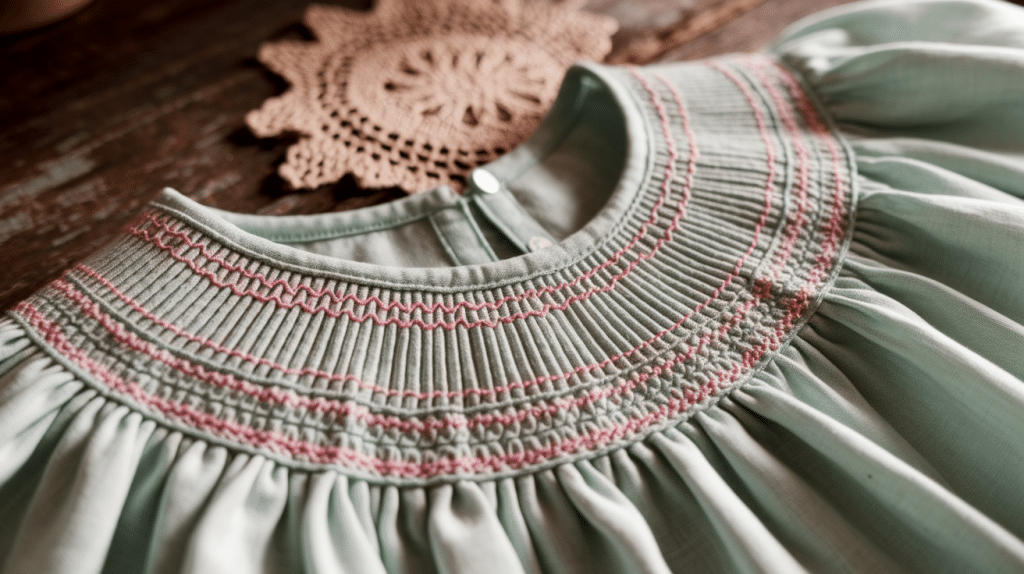Smocking is a captivating textile art that transforms simple fabric into intricate, textured masterpieces.
This ancient embroidery technique has woven its way through centuries of fashion and craftsmanship.
From medieval European workshops to modern design studios, smocking continues to enchant creators and admirers alike.
The craft involves carefully gathered fabric, creating beautiful patterns that tell stories of skill and creativity.
Artisans use specialized stitches to manipulate cloth, turning flat material into three-dimensional, expressive designs.
Whether adorning baby clothes or elegant garments, smocking remains a testament to human artistic ingenuity.
What is Smocking?
Smocking is an ancient embroidery technique used to gather fabric into intricate, decorative patterns.
It originated in Europe, specifically in the 16th century.
Traditionally, smocking was used to shape garments and add elegance to clothing.
It involves sewing pleats or gathers into fabric, often creating a textured effect.
The technique employs a range of stitches, including running and backstitches, to create the design.
Smocking was historically popular for making dresses, blouses, and bodices.
Over time, it evolved into a decorative feature on various items, such as cushions and quilts.
Today, smocking remains a cherished skill, with modern designs adding complexity to the ancient art form.
It remains in use in both fashion and home decor.
History of Smocking
Smocking originated in the Middle Ages as a practical way to gather fabric, primarily for men’s shirts.
Over time, it evolved into an intricate embroidery technique, used to create decorative patterns and give shape to clothing.
During the 18th century, smocking became a prominent feature in European fashion, particularly for women’s dresses.
The technique reached its height of popularity in the 19th century when it was used extensively in both men’s and women’s garments.
In different cultures, smocking was adopted as a sign of craftsmanship and status.
In the United States, smocking became particularly associated with children’s clothing, where it is still cherished for its historical charm and craftsmanship today.
The enduring appeal of smocking lies in its timeless aesthetic and connection to cultural heritage.
Techniques Involved in Smocking
Smocking involves various stitches to create intricate, gathered designs.
The running stitch is the most basic, providing even gathering.
The cable stitch creates a raised, twisted effect that adds texture.
The honeycomb stitch forms a tight, woven pattern, ideal for structured pieces.
The wave stitch adds gentle curves to the fabric.
Each stitch serves a unique purpose, contributing to the overall texture and movement of the design.
Materials and Tools Needed
To get started with smocking, you’ll need a few essential materials and tools:
-
Cotton or linen fabric, which holds pleats well.
-
Smocking thread for durability and smooth stitching.
-
Embroidery needles for fine detail work.
-
Scissors to trim threads and fabric edges.
-
Smocking pleating board for even pleats.
-
Thimble for protection while stitching.
These basic materials ensure you can start your smocking projects efficiently and beautifully.
Applications of Smocking
Smocking is widely used in both traditional and modern clothing.
In dresses and blouses, it creates a fitted, decorative effect.
The technique adds texture and movement, enhancing the garment’s overall design.
Smocking is also popular in baby garments, providing a charming, vintage appeal while offering comfort.
In modern fashion, smocked details are often incorporated into casual wear, such as tops and skirts.
Beyond clothing, smocking has made its way into home décor, especially in accessories like pillow covers and cushions.
The technique adds a unique, handcrafted touch to interior design items, giving them a timeless, elegant look.
Smocking can also be used on curtains and table linens, adding depth and character to home spaces.
Its versatility continues to influence both fashion and décor.
Benefits of Smocking
Smocking is highly valued for its aesthetic appeal due to its intricate and textured designs, making garments more visually interesting.
The carefully crafted stitches form beautiful patterns that enhance the overall look of any piece.
Beyond its visual charm, smocking also offers functional benefits, particularly its ability to stretch.
The gathered fabric allows garments to fit comfortably, adapting to various body shapes.
This stretchability adds versatility to smocked clothing, making it suitable for different occasions.
Additionally, the textured nature of smocking provides a unique structure to garments, giving them more shape and form.
Its combination of beauty and practicality makes smocking a timeless choice for both decorative and functional clothing.
Beginner’s Guide to Smocking
Getting started with smocking can be a fun and rewarding creative journey. By following these steps, you’ll quickly gain confidence and skills in this intricate craft.
Steps to Start Smocking:
-
Choose the Right Fabric
Begin by selecting a lightweight fabric like cotton or linen, which holds pleats well and is easy to work with. -
Prepare Your Fabric
Use a pleating board to create even, uniform pleats before you begin stitching. This is an essential step for accuracy. -
Practice Basic Stitches
Start by practicing the basic running stitch, which is the foundation for many smocking patterns. Master this first. -
Experiment with Simple Patterns
Once comfortable, try simple smocking designs such as the wave or honeycomb stitch. They are perfect for beginners. -
Work Slowly and Carefully
As you stitch, ensure your gathers are even and your stitches are uniform for a consistent, professional look. -
Start with Small Projects
Begin with smaller items like baby clothes or pillowcases. These projects are perfect for learning and practicing.
Smocking takes patience and practice, but with each step, you’ll improve.
Soon, you’ll be able to change simple garments into beautiful, textured pieces of art!
Common Mistakes and How to Avoid Them
While smocking is a wonderful craft, beginners often face some common pitfalls.
Here’s a table to help you avoid mistakes and improve your smocking technique.
| MISTAKE | HOW TO AVOID IT |
|---|---|
| Uneven Gathering | Ensure pleats are evenly spaced for a balanced design. |
| Incorrect Stitch Tension | Maintain consistent tension to avoid loose or tight stitches. Practice control over your thread. |
| Losing Track of Stitch Patterns | Mark fabric with light pencil lines to keep track of stitch patterns. |
| Rushing the Process | Work slowly and check your progress regularly to avoid errors. |
| Using the Wrong Fabric | Stick to fabrics like cotton or linen, which hold pleats well and make the gathering easier. |
By keeping these tips in mind, you can avoid the most common mistakes in smocking and ensure smoother, more beautiful results.
Summing It Up
As fashion evolves, smocking stands as a bridge between traditional craftsmanship and contemporary design.
Its enduring appeal lies in the delicate balance of function and artistic expression.
Makers continue to explore and reinvent this ancient technique, breathing new life into age-old skills.
From home décor to high fashion, smocking offers a unique way to add texture and personality.
The art requires patience, precision, and passion.
Each stitch represents a connection to generations of textile artists who have preserved and celebrated this remarkable craft.
To read more activity-related Blogs. Explore here










